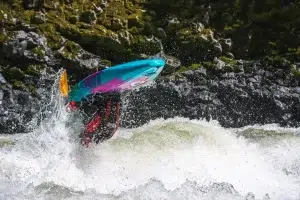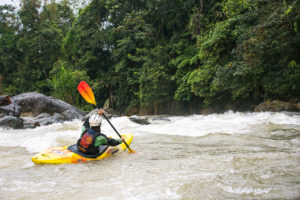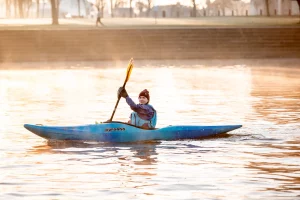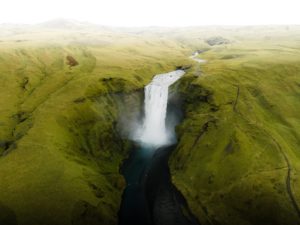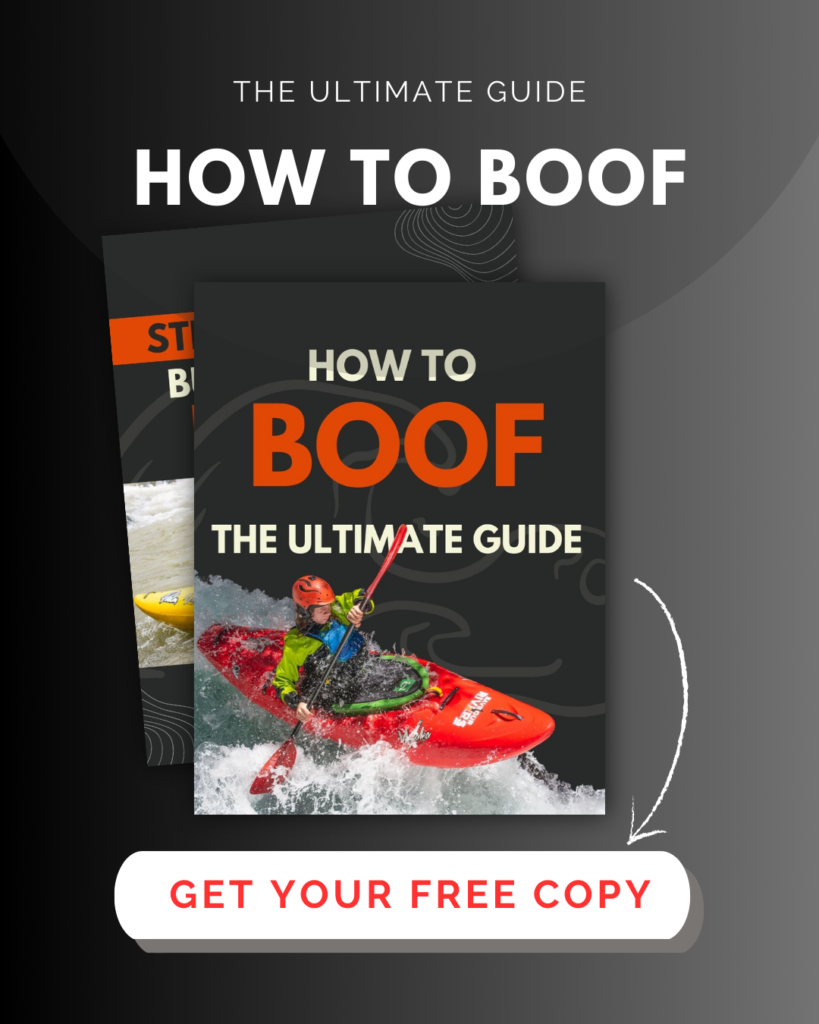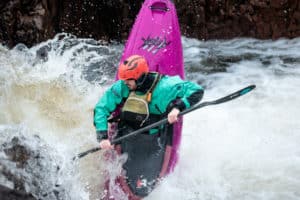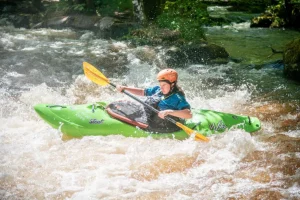One of the most important and most commonly used moves in kayaking is the Boof.
But what is it?
Boofing is the act of pulling yourself over a feature on a river, by pulling your bow up and keeping it on top of the surface of the water.
Why do you need to learn to boof?
Apart from being stylish as heck…
Boofing is a key aspect of navigating a river.
It’s important because of
- Safety: Being able to boof can help you safely navigate holes and other obstacles on the water.
- Efficiency: Boofing allows you to carry momentum and keep your speed up.
- Control: Boofing allows you to have much more control in your kayak and gives you the ability to choose where you want to go, not to be at the mercy of the river.
- Style: Wait we said this one…
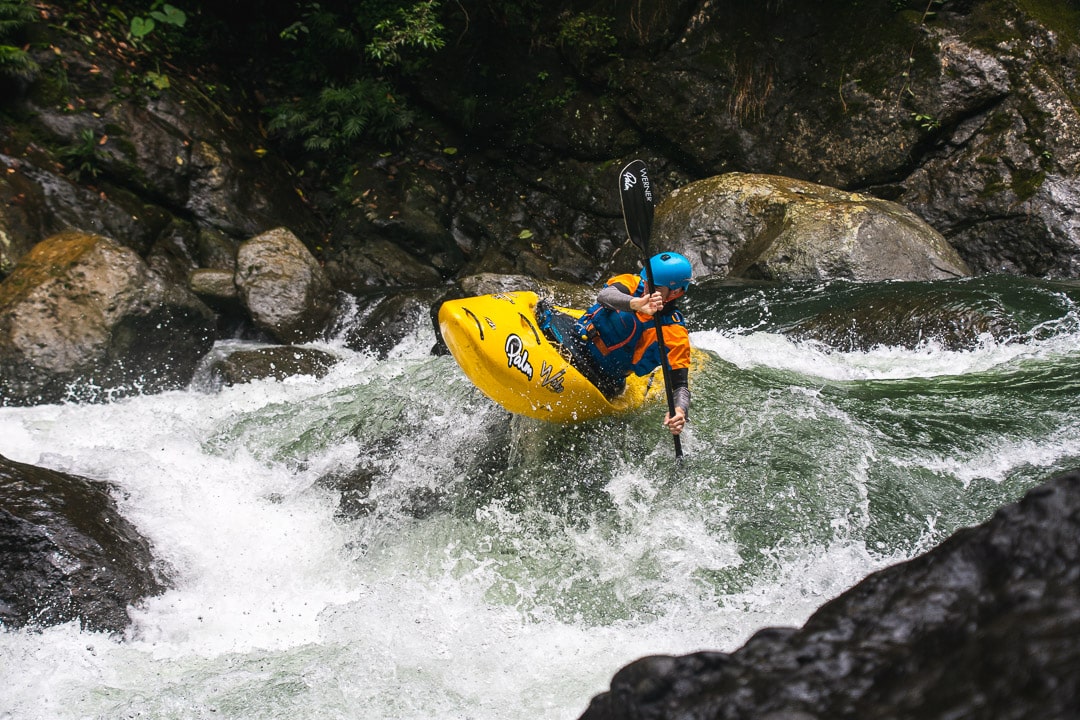
Here are some tips to help you boof like Dane Jackson:
Tip #1: Grow up in a boat, being taught by a World Class paddler.
Well that would help
but seriously,
How to Boof a Whitewater Kayak:
1. Build Momentum
Build up your speed before attempting the move.
The faster you go, the more momentum you’ll have to carry yourself over the obstacle.
Think about it…
Will you be able to jump further if you are standing still or if you have a run-up?
It’s the same on the water.
The more speed you have the further you are going to be able to get away from the feature.
If you let yourself be pulled by the water, you’re just going to go where the water is going.
Which is down.
There is a time and a place for a slow boof.
But when you are learning and to get that stylish rocket-like photo shot then you want to come into the move with some speed.
2. Time Your Stroke
Your paddle stroke timing is important.
You want to grab the water and use it to pull yourself up and over the feature.
As you approach the feature place the paddle in the green water (water that is flowing downstream) just before or on the lip of the drop/hole.
If you are boofing a wave, you want to place the stroke just before its peak.
If you are boofing a hole, just before the water starts going down.
If you are boofing a drop, you can use the lip of the fall to place your paddle.
Personally, I’ve found placing the stroke slightly before the feature always gives me the most control and performance.
You want your paddle nice and vertical and take a long and slow stroke
Don’t yank it!
This is where I see a lot of people going wrong.
But we’ll get onto this…
3. Thrust your hips
You want to pull yourself past your paddle stroke.
Push with your feet as you pull with your paddle, thrusting your hips past your blade.
This is what will send you forward.
If you do this correctly, you will carry your momentum forward where you are connected to the boat.
Bringing the boat out and away from the drop.
4. Crunch Forward
What you don’t want to do however is thrust your hips and lean back.
This will bring your bow down and you will plug.
Instead, crunch forward and picture bringing your knees to your head.
This will help bring the bow up and keep you flat off the drop.
Crunching forward also allows you to keep your core tight which increases stability and control in the air and the landing
This will also help with softening the impact and protect your back if you are boofing larger drops.
Use a slight edge to shorten the rocker profile and make it easier to pull up. By slightly edging your kayak, you can reduce the amount of water that’s pushing against you, making it easier to pull up and over the obstacle.
5. Take a stroke
On landing, you want to take a stroke to keep your momentum up and away from the feature.
There is nothing worse than flying through the air and celebrating just before you get pulled back into the feature.
Take a paddle stroke, keep your speed up and set yourself up for the next move.
Bonus Tips for Better Boofs
That’s the simple how-to but here are a few tips to help you improve your boof:
Tip#1: Don’t yank
Take a long, slow stroke and keep tension in the water for as long as possible
Don’t jerk it.
If you are boofing properly it will just be a continuation of a forward paddle.
A slow, steady stroke will give you the most power and control, allowing you to smoothly transition over the obstacle.
As soon as you take your paddle out of the water you lose control over your boat.
Keep the paddle and tension in the water to really level up your boof.
Tip#2: Stomp the landing
This is especially important for taller boofs.
Stomping is a way of softening the landing and protecting your spine.
It’s almost like a suspension.
Whatever you do
DO NOT
land sitting bolt upright
This is a recipe for a broken back.
By leaning forward and pushing your feet down, just before impact.
You will soften the blow and keep yourself safe down the river
Tip#3: Edge
Edging as you boof can make it easier to bring the bow up
This is because you are shortening the rocker profile.
You don’t need to lean all the way over, but a slight edge can help you bring the nose right up.
Tip#4: Watch Videos
If you are just learning or want to improve your boof, spend some time watching some footage of some of the best paddlers out there.
See where they place their strokes
How they edge
When to use side sweeps or when to pull massive strokes.
Watching the best do what they do can help you learn the principles which you can then replicate on the water.
Try this video for example:
Tip#5: Pinkies out
I’ll be honest, this has no benefit other than looking cool…
Boofing is a move that takes time and practice to master, so don’t get discouraged if you don’t nail it right away.
You can practice it on small holes, eddy lines, drops and waves.
Or even just on flat water.
Keep practicing, stay safe, and have fun out there!
See you in the next one,
WWKH
P.S. Check out our How to Loop Article too!
